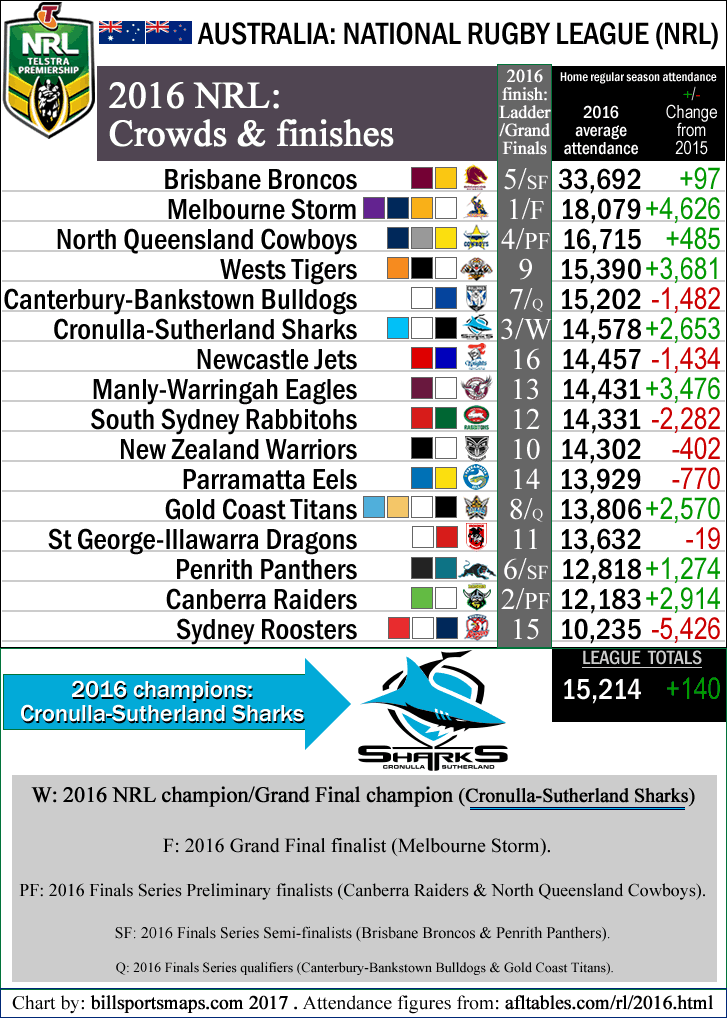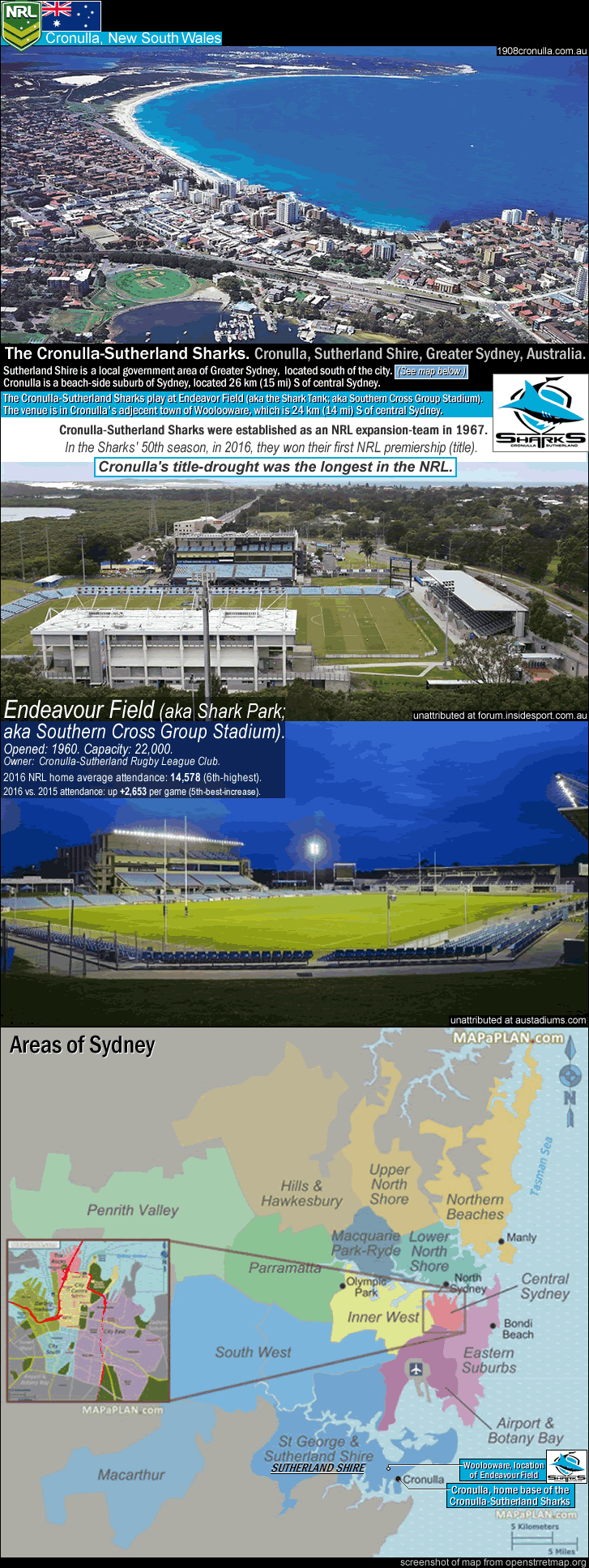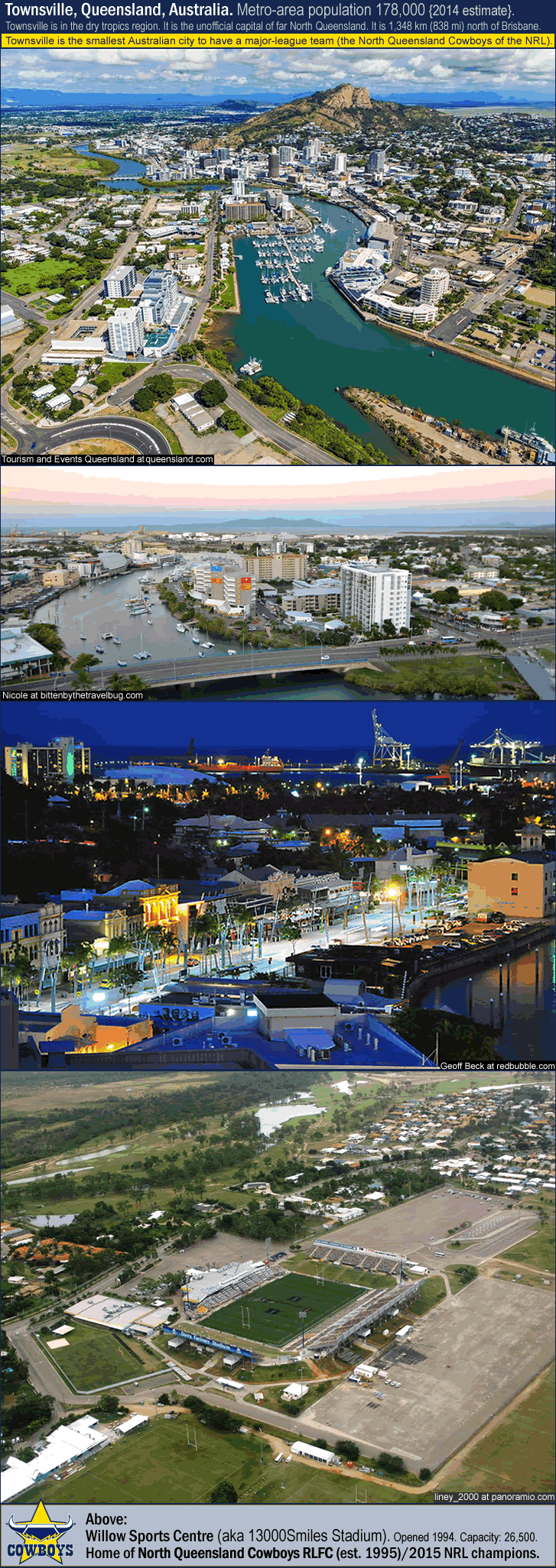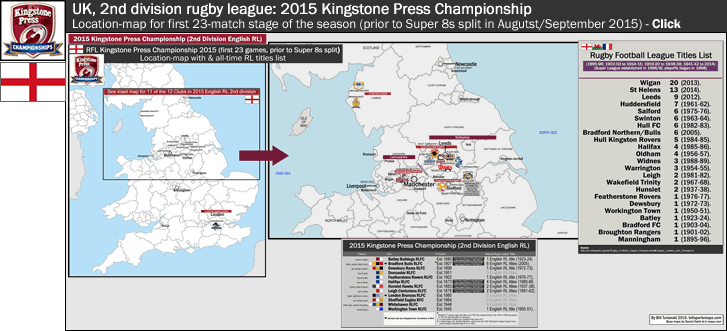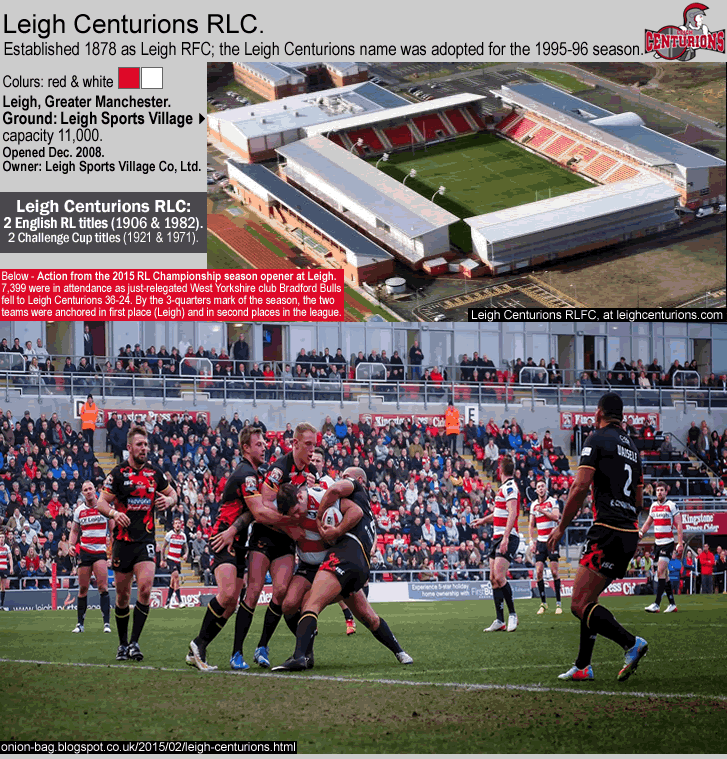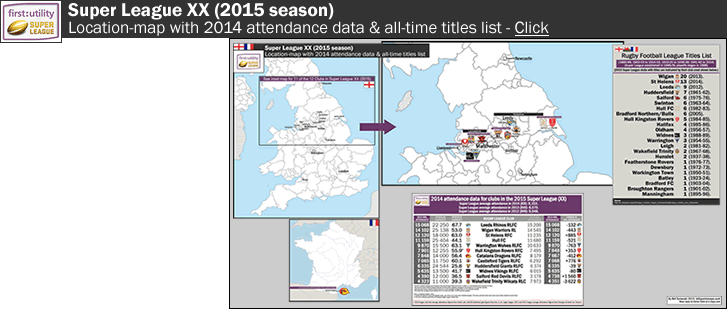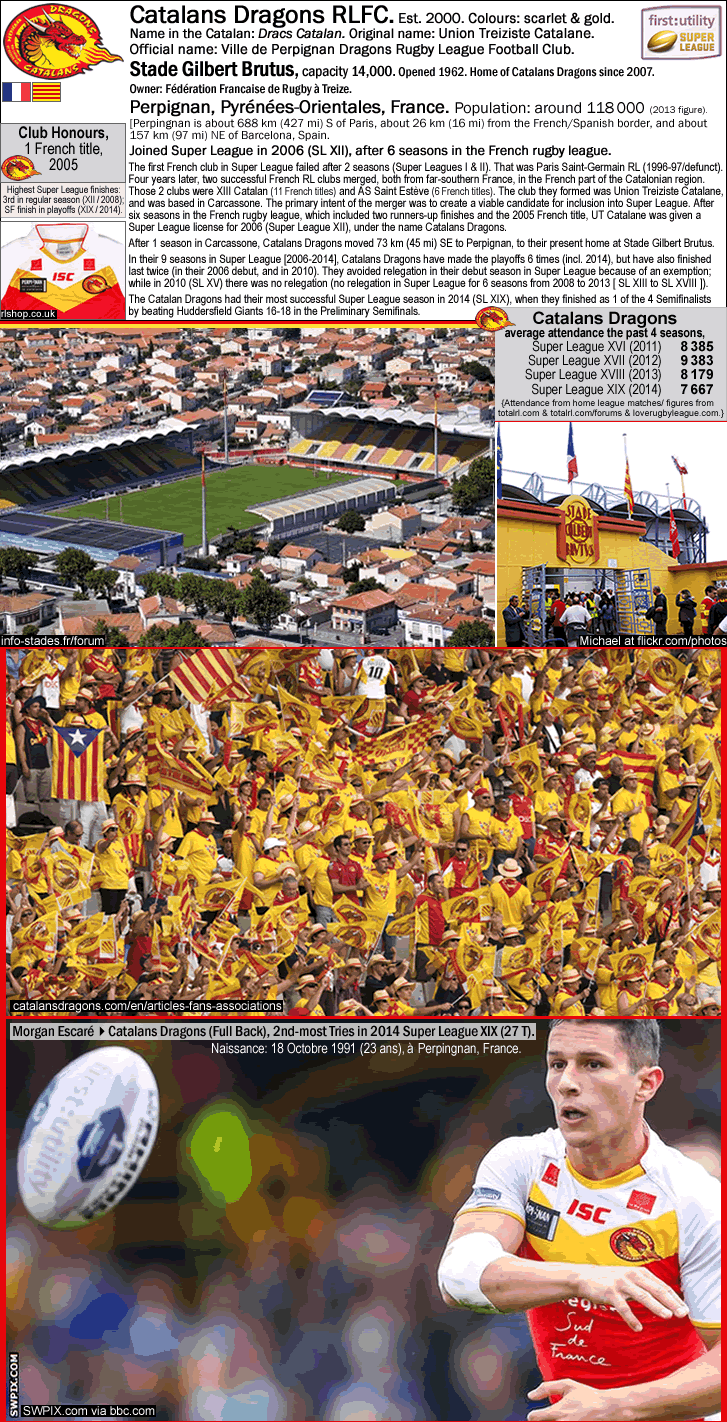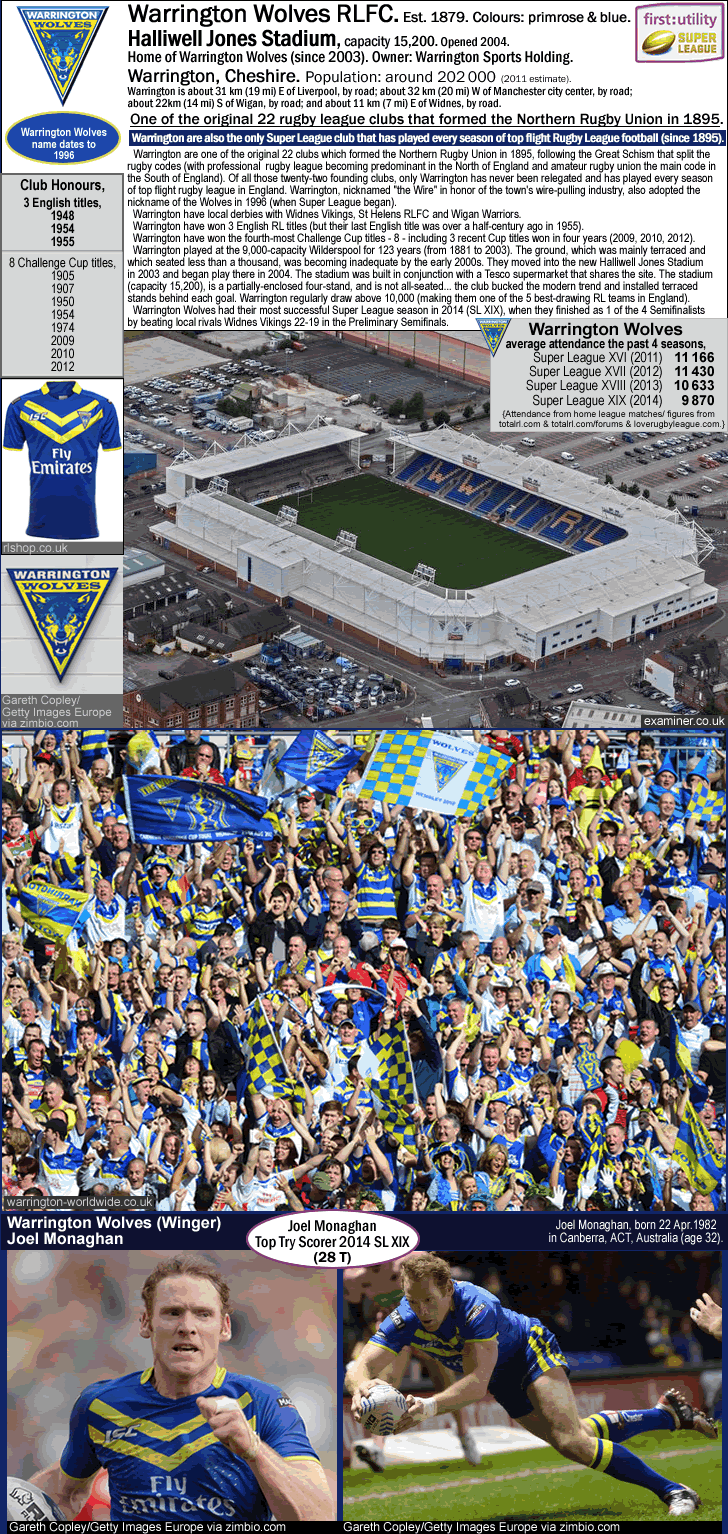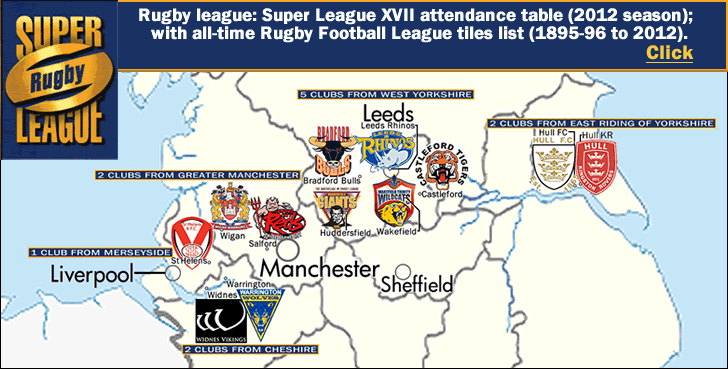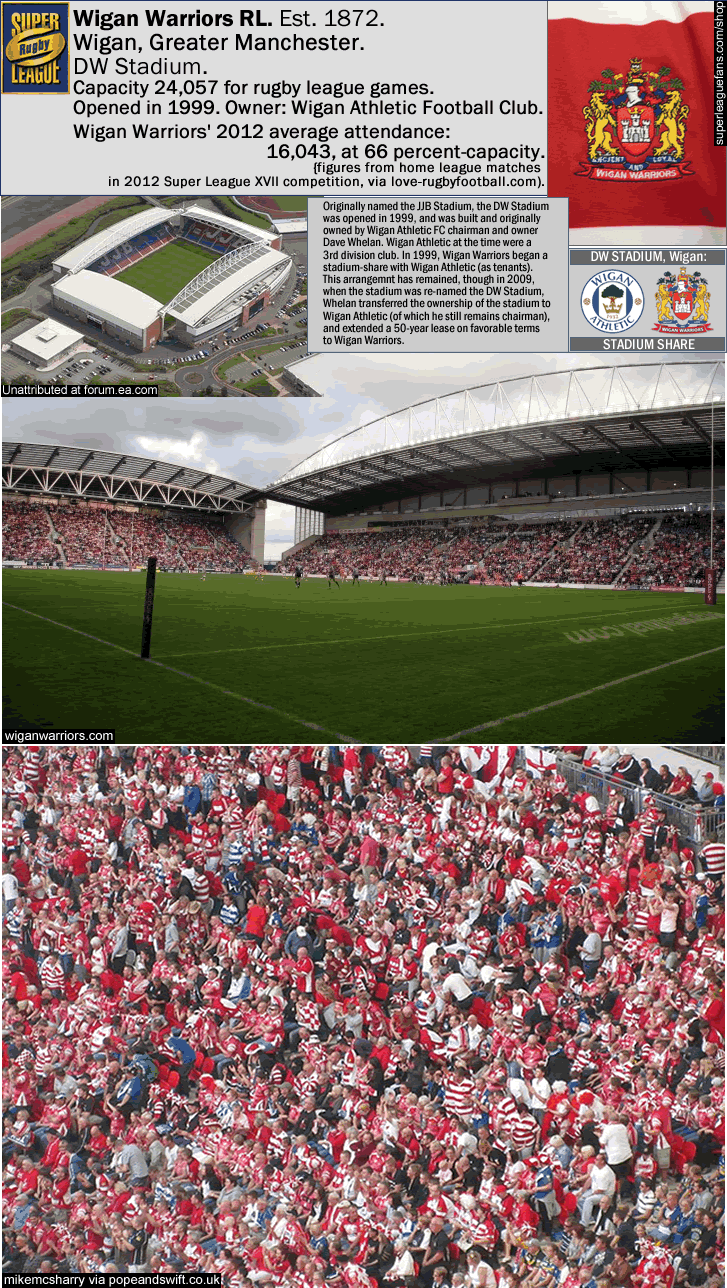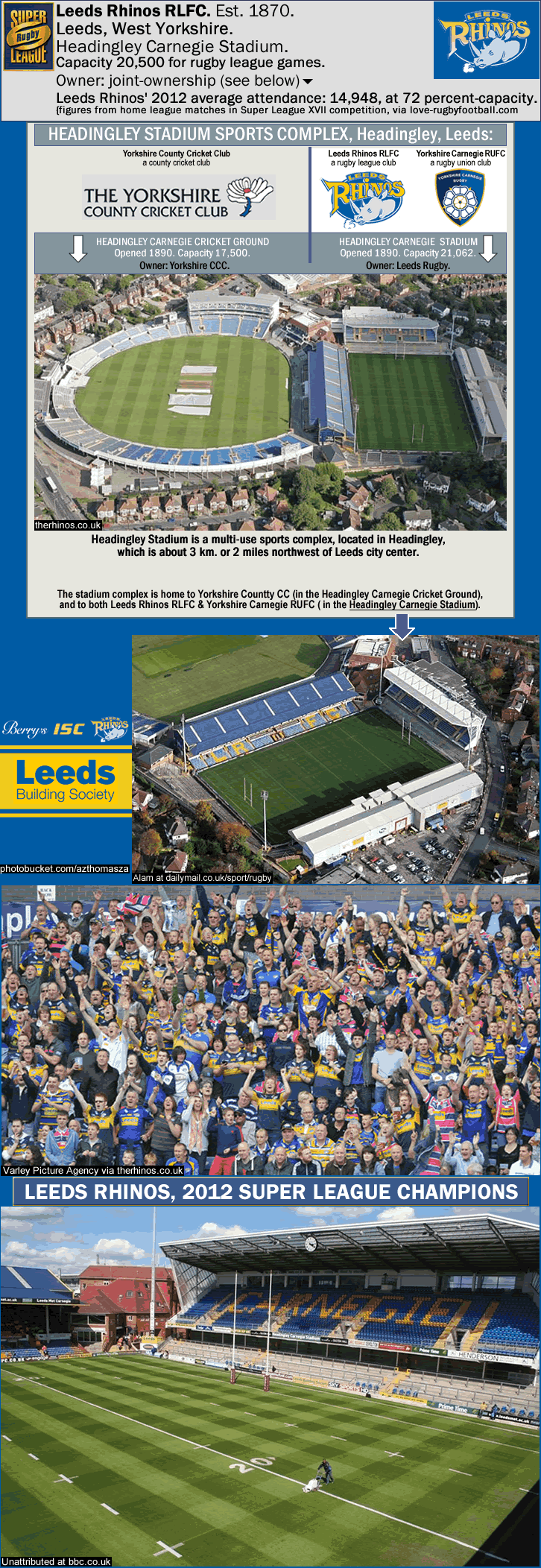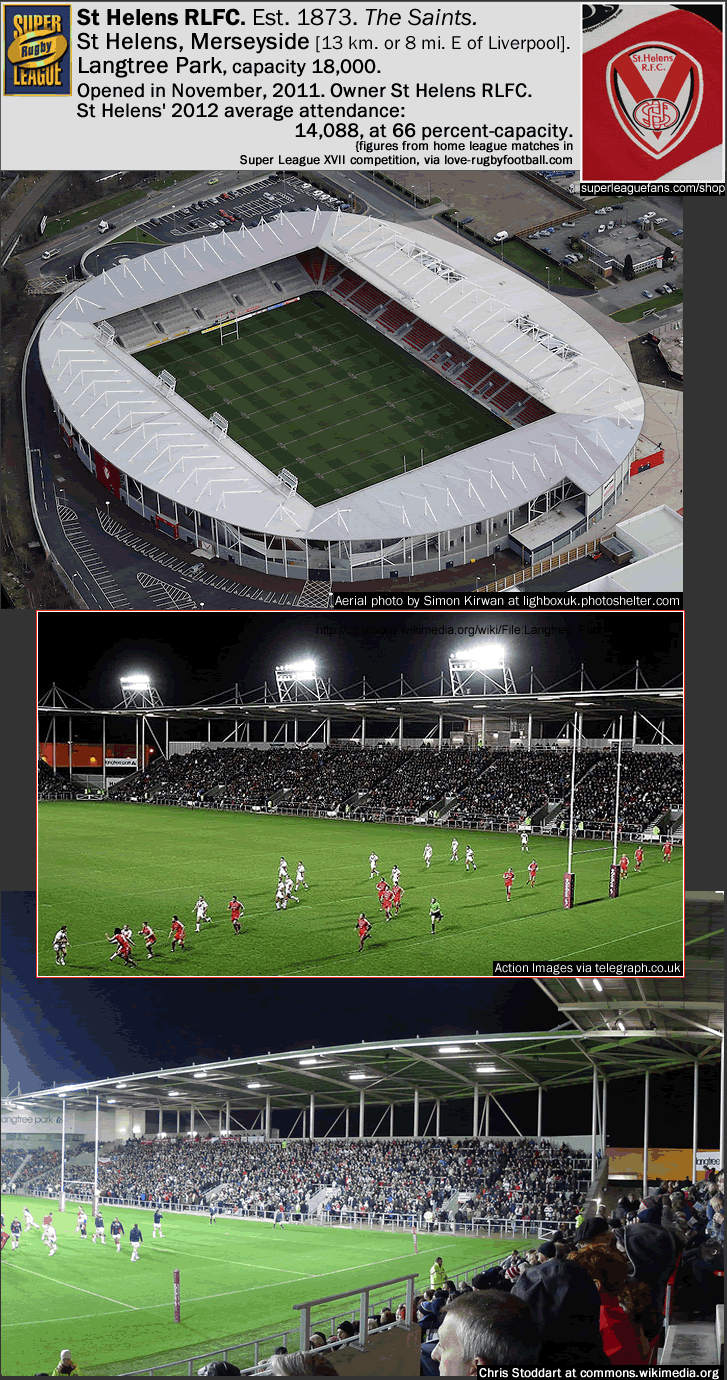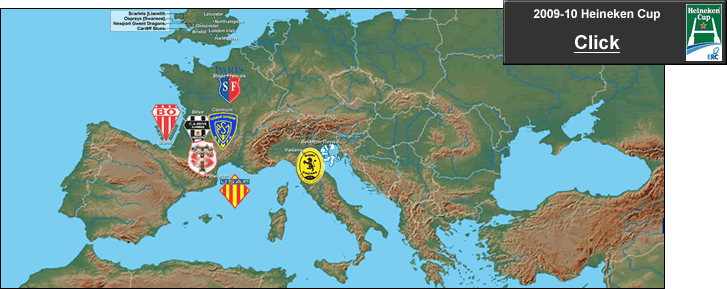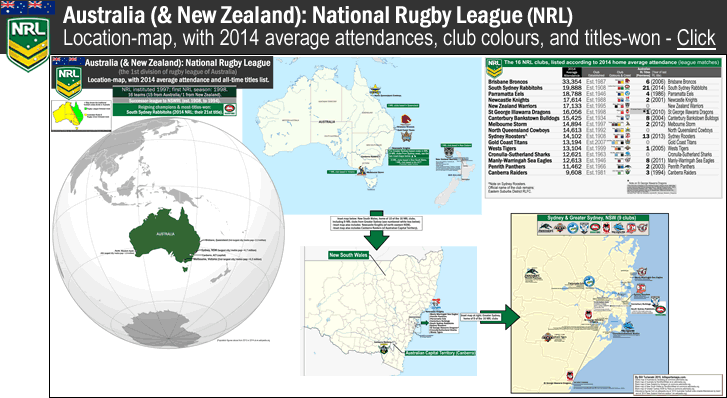
Australia (and New Zealand): National Rugby League, 2015 location-map with 2014 attendances and titles listed
…
…
Links…
-Teams…National Rugby League/ Current clubs (en.wikipedia.org).
-Live scores, schedule, table…livescores.ninemsn.com.au/nrl.
-NRL at LoveRugbyLeague.com…loverugbyleague.com/nrl.
-Official site of NRL…nrl.com.
Australia (and New Zealand): National Rugby League (NRL) -
2015 location-map with a chart which shows…2014 attendances by club, club colours & crests, and titles (Premiers)
By Bill Turianski on 11 May 2015; twitter.com/billsportsmaps.
Updates…
-Crowds-&-finishes chart for 2016 season of the NRL, with 2016 Premiers (champions), the Cronulla-Sutherland Sharks.
-Crowds-&-finishes chart for 2015 season of the NRL, with 2015 Premiers (champions), the North Queensland Cowboys.
…
Size and population of Australia…
I will start of with a brief description of the size, relative size, and population of Australia. If you click on the following link you can see, at a glance, how massive the island/Continent of Australia is when it is compared to the Continental USA, {here (aboutaustralia.com)}. (Note: that graphic can also be seen at the far-lower-left-hand corner of the map page.) As you can see in that graphic, Australia is about the same size as the Continental USA, but when you factor in Alaska (and Hawaii), Australia ends up being about 23% “smaller” than the 50 United States. Australia is the 6th-largest country on Earth, at around 7.6 million km-squared (or around 2.9 million miles-squared), which makes it about 10% “smaller” than the 5th-largest country – Brazil, and more than twice the size of the 7th-largest country – India. To put it another way, Australia is massive. It is also not very populous for its size, because Australia is only the 52nd-most-populous nation, with a population of around 23.7 million {2015 figure}. To give you an idea of how sparsely populated Australia is, it has slightly less inhabitants than the pretty-small-sized nations of Nepal, Ghana, or North Korea. {Sources of data: sizes: List of countries and dependencies by area; populations: List of countries and dependencies by population (both from en.wikipedia.org).}
The Big 5 Cities in Australia…
There are 5 major cities in Australia, 3 of which have NRL teams (Sydney [9 teams], Melbourne [1 team], Brisbane [1 team]). On the map page, in the globe-map at the far left there, I have placed those 5 cities along with their populations. Sydney is the largest city in the country, with around 4.7 million inhabitants (in the metro area/urban population/all listed here are 2013 or 2014 estimates). Melbourne is the second-city of Australia – but only just…it has a population of only about 300 K less than Sydney, at around 4.4 million. Brisbane is third-largest, at about 2.3 million; Perth is fourth at around 2.0 million; and Adelaide is fifth at around 1.2 million. The capital of Australia, Canberra (which is situated in the small Australian Capital Territory, located midway between Sydney and Melbourne) is a rather small city [but it nevertheless does have an NRL team], and is the eighth-largest Australian city, with about 411,000 inhabitants. {Sources, each city’s Wikipedia page for the most-recent population estimates, however the following link is relatively recently updated (2012 figures), List of cities in Australia by population (en.wikipedia.org).}
…
There are 4 football codes in Australia which have professional major leagues (the most of any country)…
There are 4 football codes in Australia (listed below with first-division 2014 league-average-attendances):
Australian rules football (1st division: AFL, which averaged 32,327 per game in 2014).
Rugby union football (1st division: Super Rugby, which averaged 16,913 per game in 2014).
Rugby league football (1st division: NRL, which averaged 15,787 per game in 2014).
Association football [aka soccer]: only pro division: A-League, which averaged 14,759 per game in 2014).
[source: http://en.wikipedia.org/wiki/2014_Australian_football_code_crowds#Attendances_by_league.]
An extremely simplified guide to the 4 football codes’ popularity in Australia…
Aussie rules football…
To simplify it in the extreme, Australian Rules Football, which originated in the 1860s in and around Melbourne in the state of Victoria, turned semi-pro when the AFL was formed in 1897. Although first division teams were not based in any of the other states and territories of the country for almost 90 years (until the 1980s and 1990s), Aussie rules football has always been hugely popular throughout all the 8 states and the 2 territories of Australia, with the exception of New South Wales (NSW) and Queensland. In and around Sydney (which is the capital of New South Wales) and in all of Queensland (including Brisbane), Australian rules football has been historically overshadowed by rugby league football. The split described in the last two sentences can be see in the map at Barassi Line (en.wikipedia.org) {that map is also at the top-left-hand-side of the map page}.
Soccer (aka association football), in Australia…
Soccer was widely shunned by many if not most Australian fans and players for decades (ie, only “Sheilas, Wogs & Poofters” played soccer, as the bigotry of the day held [circa 1950s through '80s]). Only in the last decade-and-a-half or so has soccer become a viable pro sport in Australia. And now, going into the 2010s, soccer has made significant gains in popularity, to the point that the Australian first division in soccer (the A-League) is currently drawing only marginally less than both rugby codes in the country (see list with league-attendance 2 paragraphs above above).
The 2 Rugby codes in Australia…
Rugby Union, a little over a century ago, became the major sport of the city of Melbourne and of the state of Victoria. The highest level of competition in Australia is the National Rugby Championship, although there is a higher tier that involves teams from South Africa, New Zealand, and Australia, Super Rugby.
Rugby League, a little over a century ago, became the major sport of the city of Sydney and of the state of New South Wales (as well as the major sport of Brisbane in Queensland). The highest level of competition in Australia is the National Rugby League (NRL), which has 16 teams (9 teams from New South Wales).
…
On the map page…
The map page is a bit complicated, owing to the Sydney-centric nature of first-division rugby league in Australia – 9 of the 16 NRL teams are from Greater Sydney (all are listed in the next paragraph), plus there are 2 more teams nearby…one team in northeast New South Wales (Newcastle Knights) and one team in the Australian Capital Territory (Canberra Raiders). So there are three maps that comprise the location-map aspect of the map page. First off, is the map at the upper center of the map page, which includes all of Australia and New Zealand, and shows the other 5 clubs in the NRL…3 teams based in Queensland (North Queensland Cowboys, Brisbane Broncos, Gold Coast Titans)), one team based in Victoria (Melbourne), and one team based in New Zealand (New Zealand Warriors).
The next map, at the lower center of the map page, shows all of New South Wales state and it features the locations of all the 9 Greater Sydney teams, plus the Newcastle team and the Canberra team. The 9 Greater Sydney-based teams are then shown in the third map at the lower right-hand part of the map page – that is an enlarged inset-map of Greater Sydney…there you can see the more precise locations of the 8 NRL teams that play all their games in greater Sydney (Manly-Warringah Eagles, Penrith Panthers, Parramatta Eels, Canterbury-Bankstown Bulldogs, South Sydney Rabbitohs, Sydney Roosters, Cronulla-Sutherland Sharks, Wests Tigers). Also shown in the Greater Sydney inset map is the team that has two locations (St George Illawarra Dragons), who play half their home games in the St George neighborhood of south Sydney and the other half of their home games in Woolongong, NSW, which is about 80 km or 50 mi south of Sydney.
The other two features of the map page are…a globe-map of Australia at the far left-hand side (featuring the 5 biggest cities in the country plus the capital); and
a chart at the upper-right-hand side which lists 4 things:
1). 2014 home regular season average attendance;
2). the year the club gained admission to the NRL or its predecessors;
3). club crests and colours;
4). Australian RL titles (aka Premiers) won by each club, with last title-year listed.
…
History of First Division Rugby League in Australia (1908 to 2014)…
The path to the NRL – the first 88 years of Rugby League in Australia…
From the Wikipedia page National Rugby League/Origins and beginnings…{2 excerpts}…
…”The New South Wales Rugby League (NSWRL) ran the major rugby league competition of New South Wales from its inception in 1908 until 1994, by which time its powers had expanded to run the code nationally. Following the introduction of a new format for interstate rugby league, the State of Origin series in 1980, the decade of the 1980s brought about expansion of the NSWRL premiership, with the…addition of non-Sydney-based teams, Canberra and Illawarra in 1982.” /…”Further expansion of the league followed in 1988, with another three teams based outside Sydney introduced to the competition; the Newcastle Knights and the first two Queensland teams, the Brisbane Broncos and Gold Coast-Tweed Giants.”…{end of excerpts}.
1995…
With a major threat looming on the horizon (see below), the NWSRL became known as the Australian Rugby League (ARL) in 1995; that same year, there were four more expansion teams…Auckland Warriors, North Queensland Cowboys, South Queensland Crushers and Western Reds [of Perth, Western Australia]. The former two of those four – the Warriors of NZ and the Cowboys of North Queensland – still exist. But the latter of those four – the South Queensland team and the Perth team – became a couple of the many casualties of the Super League War.
In 1996, Rupert Murdoch tries to gain the television rights to Australian rugby league, and the Super League War is initiated…
Then in 1996 and 1997, Rupert Murdoch wanted the television rights in order to establish a (very lucrative) pay-television scheme, so he formed a short-lived rival major league by luring prominent ARL club executives, coaches, and players with bags of cash. But it must be pointed out that many of the 8 clubs which jumped ship to Murdoch’s phony league were threatened by Murdoch had they stayed put. Sick of the salary cap in the ARL thwarting their ambitions, Brisbane, Canterbury, and Auckland went over to Murdoch’s league willingly. But as to the others, Murdoch coerced some of those 1st division rugby league clubs into joining his new league, or face the threat of having to compete for the fan-dollar against theoretical new rival-teams that Murdoch would have put in those clubs’ neighborhoods. By April 1996, Murdoch’s News Limited began to sign up target clubs, some of whom had already lost key personnel to Super League. “Club representatives were told that if they did not join Super League, they would face rival clubs established in their area.” {quote from Super League war/The war at its peak (en.wikipedia.org)}. That threat by Murdoch & Company was in fact carried out in one place – the Hunter region of northeast New South Wales (where the city of Newcastle, NSW is located, and where the then-ARL team/now NRL-team the Newcastle Knights are located). So, because the Newcastle Knights stayed put in the AFL, they were suddenly forced to compete in their region in 1997 with the hastily-formed and poorly-supported Hunter Mariners (who were established in 1997, played the ’97 season in Murdoch’s league, then were wound up in late 1997). Poetic justice can be found in the fact that the Newcastle Knights held steadfast, refused to buckle to Murdoch & Company, stayed put in the ARL, and then went on to win the ARL premiership in that twisted year of 1997.
Here are the 8 RL clubs [7 which still exist today, as NRL teams], that jumped ship for that cash-fueled league that Murdoch foisted upon RL fans in 1997…
Auckland Warriors [now named New Zealand Warriors]
Brisbane Broncos
Canberra Raiders
Canterbury Bulldogs [now named Canterbury-Bankstown Bulldogs]
Cronulla Sharks [now named Cronulla-Sutherland Sharks]
North Queensland Cowboys
Penrith Panthers
Western Reds [defunct]
-See this [if you want a headache], Super League war (en.wikipedia.org)/
-See this [if you want it explained short and sweet], from the National Museum of Australia site, Super League (nma.gov.au).}
-Here is a “TL;DR” version of the events around the Super League War, from Reddit.com/RL commenter Socc13er37 [link to the original thread is further below]…
…{excerpt}…
…”[1] Two media moguls, Kerry Packer and Rupert Murdoch, fight over TV rights for the ARL. Packer purchased them in 1993 and Murdoch tried to take the currently dead Pay TV rights, which he did. Packer gets pissed and says he has all the ARL TV rights, and the brawl brews over from there.
[2] Meanwhile, Brisbane CEO John Ribot is unhappy with the current state of the league for his Queensland side, and wants to make his own league, with a global audience and Murdoch-owned teams, called the Super League. ARL and the clubs say “Fuck that” and unanimously decline.
[3] Ribot and Murdoch “go into their evil lair” to plan out how they make the Super League dream a reality. They offer massive salaries and signing bonuses to clubs like Canterbury, Auckland and Brisbane, who all sign on. The ARL find out and plan to expel said clubs from the competition. Murdoch states he won’t let that happen and will compensate the clubs if legal action occurs.
[4] The ARL can’t stop the News Ltd SL train. 8 clubs sign on to join the Murdoch-run league and they look to be riding high, but the court brings them down. The ARL runs the show here, and the Federal Court says there will be no SL until 2000, which was then reduced until this year. Then, the court overturns the decision, and says that the Super League will run in 1997. The ARL appeals, but loses in less than 40 minutes of court proceedings, and results in the CEO’s resignation.
[5] During the two leagues running simultaneously, a lot of clubs lost money and sponsorship was spread thinly. Eventually, the Super League with its extravagant amount of spending couldn’t hold it together, and there was a merger back together, to make the NRL.”…{excerpt from comment made by Socc1er37 at the Reddit.com/r/NRL thread entitled Can someone outline what happened during the ‘super league war’ period of time? (reddit.com/r/nrl/comments).
Murdoch’s cash-fueled league (1997/merged with ARL to form NRL in 1998)…
The 1997 season saw 22 clubs in two rival RL leagues. One of which – Murdoch’s league – was filled with 8 former AEL clubs and a few now-defunct expansion clubs [Adelaide and Hunter]). Fans stayed away in droves. Then in late 1997, the courts stepped in and resolved the unsustainable twin-major-leagues mess in Australian rugby league. Murdoch got some of what he wanted (some broadcast rights and co-ownership of the new league structure, as well as ownership of some clubs [he currently owns two-thirds of Brisbane Broncos, and he used to own Melbourne Storm/see 2 paragraphs below]). But more importantly, Murdoch stopped meddling with rugby league in Australia. The fallout remained for years, though/ (see below).
With the resolution of the Super League war in late 1997, the National Rugby League (NRL) is established in 1998…
In late 1997, with the resolution of the Super League war, the National Rugby League (NRL) was established, to begin its first season in 1998. The first order of business was to consolidate. Some clubs (such as St George and Illawarra) merged, in the form of joint-partnerships. Then, after the 1999 season, pushed by Murdoch’s News Limited, the NRL top brass went too far, and tried to destroy South Sydney Rabbitohs. But after a two-year exile, South Sydney and their supporters were able to fight their way back into the league.
In 2000, South Sydney Rabbitohs are excluded by NRL, but then the courts re-instate the Souths into the league (for 2002)…
-…{excerpt from wsws.org}…”[2001]…An acrimonious court case late last year in Australia’s Federal Court over the exclusion of a team from the National Rugby League (NRL) spotlights how Rupert Murdoch’s News Corporation uses sport to expand its pay TV subscriber base and secure multi-million dollar profits. The Federal Court upheld a decision by NRL administrators to exclude South Sydney, one of the clubs that founded rugby league in Sydney in 1908, from the premier national competition. The decision was followed by an angry demonstration of 80,000 rugby league football fans, which denounced the court ruling and what they saw as the takeover of their sport by the Murdoch-dominated Foxtel pay TV network, without any concern for those who participate in or support the game”… excerpt from, Australian court endorses Murdoch takeover of rugby league, by Robert Hoffman and John Roberts at wsws.org on 10 January 2001 .}
-… {excerpt from en.wikipedia.org}…”The outbreak of the Super League war involved a vision to cut Sydney sides with Souths in the firing line. Souths remained in the ARL during the 1997 season, and were then played in the National Rugby League, the merger of the Super League and ARL, from its first season in 1998. The NRL set determined to cut its competition to 14 teams and duly cut South Sydney from the premiership for the 2000 season.”…/…”Souths fought their way back through the court rooms and public rallies generating a swell of support throughout Sydney and Australia as they took on the NRL and News Limited. Souths won re-admission on appeal during the 2001 season and were brought back into the NRL competition for the 2002 season.”…{end of excerpts at en.wikipedia.org/wiki/History of the South Sydney Rabbitohs/ Fightback and Re-admission (en.wikipedia.org).
PS, Murdoch’s News Limited company’s then-ownership of Melbourne Storm saw not one but TWO titles revoked [2007 & 2009 NRL titles surrendered by Melbourne Storm] for exceeding the salary cap.
PPS, In 2012, NRL was finally free of Murdoch when …”[the] joint partnership between the sport’s already-existing national governing body, the Australian Rugby League (ARL) and media giant News Corporation…was dissolved in February 2012, with control of the NRL going to the independently formed Australian Rugby League Commission.”…{excerpt from http://en.wikipedia.org/wiki/National_Rugby_League}.
Into the 2000s, the NRL gets more established and begins to draw more fans…
Televised matches of the NRL began to draw much larger audiences, to the point where the NRL Grand Final of 2007, between Manly and Melbourne, was the most-watched television show in Australia that year. In 2010, the NRL set a record for league average attendance at 17,367 per game [total season aggregate attendance: 3,490,778].
2014 and 2015, and on…
The league still shows robust signs of health. The Brisbane Broncos, the highest-drawing rugby club in the world, draw 33 K per game. All-time & reigning-NRL-champs, the South Sydney Rabbitohs pull in 19.8 K per game. The Parramatta Eels draw 18.7 K per game. The Newcastle Knights draw 17.6 K per game. The New Zealand Warriors draw 17.1 K per game. And the NRL as a whole pulls in 15.7 K per game (which is 7.5 K more-per-game than the English first-division rugby league draws) {see this post on England’s Super League [RL]}.
And Australia’s reigning NRL champions – the club that Murdoch could not kill, the resilient South Sydney Rabbitohs – just OWNED England’s best rugby league team, by the score of 39-to-zero, in the 2015 World Club Series. {See this, South Sydney Rabbitohs steamroller St Helens to win World Club Challenge (from Guardian.com/sport/rugby by Aaron Bower on 23 Feb.2015);
…
Illustrations for: the best-drawing Rugby team in the world, the Brisbane Broncos;
and: the second-best draw in Australian RL + 2014 World RL and 2014 NRL champions, the South Sydney Rabbitohs…
Brisbane Broncos (established 1987), are not only the highest-drawing NRL team, but they also are in fact the highest-drawing rugby team in the world (at 33,354 per game in 2014). The Broncos have won 6 NRL titles, their last title having been won in 2006. This gives the Brisbane Broncos the best titles-per-seasons-played ratio in the NRL, at 21.4% (second best is South Sydney Rabbitohs at 18.3%)…

Photo and Image credits above -
2015 Brisbane Broncos home jersey, photo from nrlshop.com/brisbane-broncos.
Night-time aerial shot of Lang Park (aka Suncorp Stadium), photo from pinterest.com/source/skypac.com.au. Interior shot, photo by Getty Images via smh.com.au/rugby-league/league-news/a-journey-into-the-belly-of-maroon-beast. Shot of fans at Suncorp Stadium, photo News Limited via foxsports.com.au.
…
South Sydney Rabbitohs, second-best-drawing rugby league club in Australia, and the 2014 NRL champions…
-The following link has a nice article on the history of South Sydney Rabbitohs, and how the club’s demise and re-birth is inextricably intertwined with the aftermath of the Super League war of the late 1990s. From the ConvictCreations site, South Sydney Rabbitohs – An Australian Story.
-Here is an article which points out that the 2014 NRL Grand Final drew a larger TV audience than the 2014 Aussie rules (AFL) Grand Final, see this, Rabbitohs’ 2014 NRL grand final win the most-watched game in rugby league history (from Daily Telegraph/sport on 6 Oct. 2014, by Cory Adno).
South Sydney Rabbitohs RLC, est. 1908…
[Note: the text below is largely the same as the text within the illustration further below.]
South Sydney Rabbitohs RLC were founded in 1908, in the working-class neighborhood of Redfern, which is south of the Sydney business district, and which to this day has a sizeable Aboriginal community. The team’s nickname is believed to come from the club’s early days, when, pre-game, some players on the squad would hawk freshly caught-and-butchered rabbits, and then go on to play the match still in their bloodstained gear. The team is also known simply as the Souths. No one really knows the official reason why the team wears cardinal red and turtle green, but…if you caught and butchered a rabbit, you would probably have grass-stains and blood-stains on your gear.
South Sydney have won the most Australian RL premierships – 21 titles, but before the 2014 season, the club had not appeared in a Grand Final since 1971.
By the 1970s, South Sydney had such financial problems that they became perennial basement-dwellers. Following the resolution of the Super League war, three seasons later [in 2000], the club was excluded from the NRL, for failure to meet “financial criteria”. There then ensued mass protests of over 80,000 in support of South Sydney, and after extensive litigation, the club was re-instated into the NRL, in 2002. The club remained cash-strapped, though, and in 2006 it was voted that the club would seek private ownership. That came in the form of the heir of media conglomerate Consolidated Press Holdings, James Packer; and the film star and Sydney-native Russell Crowe. The two hold a 50-50 share of a 75% stake in the club (with the other 25% ownership of the club still retained by club members).
The Souths play at the 84,000-capacity ANZ Stadium in Sydney (aka Stadium Australia), which was the chief venue for the 2000 Sydney Summer Olympics. The Rabbitohs also play a couple of home games each season out in Perth, Western Australia {see this, List of Australian rugby league stadiums/ Occasional Stadiums}.
In 2014, South Sydney averaged 19,888 per game, making them the second-best drawing team in the NRL. In the 2014 NRL Grand Final, in front of 83,833 at the ANZ Stadium in Sydney, the South Sydney Rabbitohs beat the Canterbury-Bankstown Bulldogs 30-6, to win their first NRL Premiership in 43 years.

Photo and Image credits above -
2015 Rabbitohs jersey, photo from rabbitohsmegastore.shopdesq.com/rabbitohs-2015-mens-home-jersey. ANZ Stadium (aka Stadium Australia), photo .
2014 NRL Grand Final,
Sam Burgess, photo by Mark Metcalfe/Getty Images AsiaPac via zimbio.com. Alex Johnston diving to score a try, photo by Mark Nolan/Getty Images AsiaPac via zimbio.com. View from the stands at ANZ Stadium during the 2014 NRL Grand Final, photo by Sam Ruttyn at dailytelegraph.com.au/the-2014-nrl-grand-final-souths-fans-pride-will-live-forever. George Burgess breaking a tackle and scoring a try, photo by Mark Nolan/Getty Images AsiaPac via zimbio.com. Rabbitohs players carrying MVP Sam Burgess off the field, photo by dailytelegraph.com.au/rabbitohs-2014-nrl-grand-final-win-the-mostwatched-game-in-rugby-league-history.
___
Sources for map page:
-Attendances (2014 season), 2014 Australian football code crowds/Attendances by team.
-Attendance for the New Zealand team (NZ Warriors), http://en.wikipedia.org/wiki/2014_New_Zealand_Warriors_season#Regular_season.
-Titles: List of NRL Premiers (en.wikipedia.org).
Thanks to Ssolbergj for globe-map of Australia, File:Australia (orthographic projection).svg (commons.wikimedia.org).
Thanks to Mdmanser for blank map of Australia and New Zealand (for use as a template), File:Map of Australia and New Zealand coloured.png (commons.wikimedia.org).
Thanks to NordNordWest for blank map of Australia, File:Australia location map.svg (en.wikipedia.org).
Thanks to Antigoni for blank map of New Zealand, File:Map of New Zealand (blank).svg (commons.wikimedia.org).
Thanks to NordNordWest for blank map of New South Wales, File:Australia New South Wales location map.svg (commons.wikimedia.org).
Thanks to Roke for blank map of Greater Sydney, File:Sydney Areas Map.svg
(commons.wikimedia.org).
Thanks to Rulesfan for map of the Barassi line, commons.wikimedia.org/wiki/File:Barassi_line_2.png.
Thanks to aboutaustralia.com.
Thanks to NRL/shop, for colours in recent NRL home jerseys, http://www.nrlshop.com.
Thanks to the contributors at en.wikipedia.org, National Rugby League/Current clubs.
